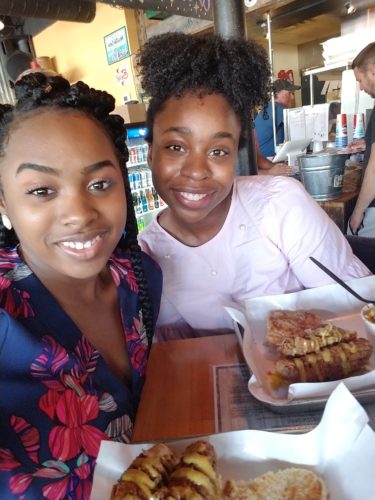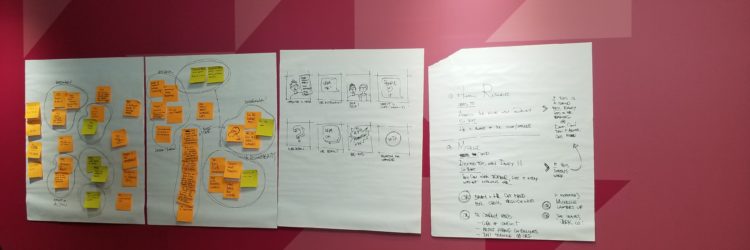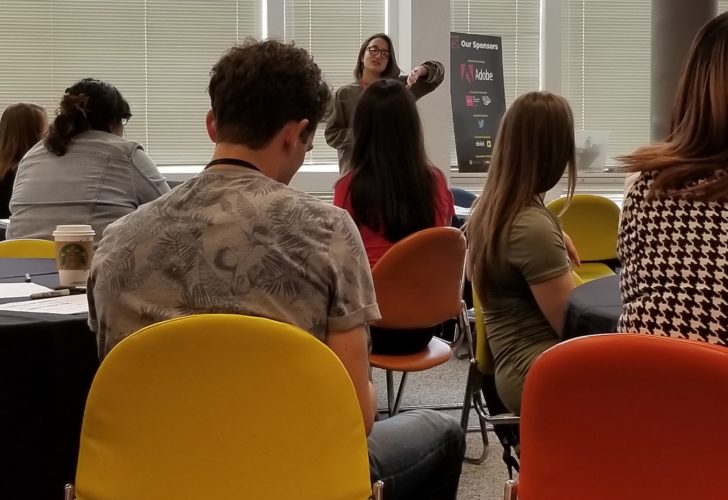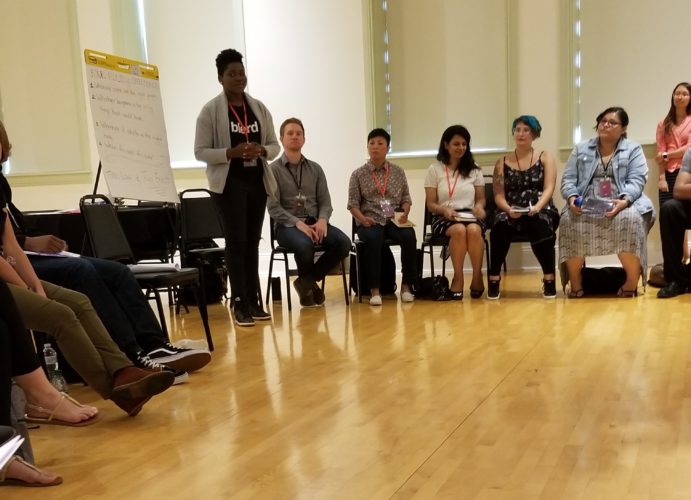2018 Design + Diversity Conference A Trip to St. Louis by Kprecia Ambers & Debbie Aderinkomi September 1, 2018
“Inspiring, celebrating, and promoting diversity within the design community.”
Background
Going on its third annual event, the Design + Diversity Conference strives to one-up themselves every year. The “conference has sought to inspire, celebrate, and promote diversity within the design community.” Their goal is to support “emerging under-represented designers with a passion to make a positive change within their communities as well as the creative industry” and their communities. Attendees can learn and make connections with industry figures as well as fellow creatives.
The Breakdown
Conference Co-founders Timothy J. Hykes and Antionette Carroll, split the information filled event into three days. Each day provided new insights and an opportunity to learn. Below is a breakdown of our mini adventure and insight on topics we learned.
Workshops
Day one took place in Centene Center for the Arts and composed of six workshops. Two workshops were run simultaneously for two hours, giving participants the option to choose which topics they wanted to explore. These workshops allowed for much interaction amongst groups, fostered discussions and allowed the opportunity to make connections. Here are the workshops we attended:
“Speaking up can educate those who are not aware of their ignorance…”
Keynote Speakers
The next couple of days took place in the conference’s second location, The Moto Museum (Pictured above with speaker Archana Thiagarajan). Each keynote speakers shared impactful stories and took the audience on a deep dive into their personal lives and company missions toward becoming more diverse and inclusive. Audience participation was highly encouraged and this allowed individuals to ask questions, share their opinions, open the floor to networking, or simply listen and reflect. Each speaker recognized the issues within today’s societies and understood the importance in working toward change. These speakers include:

The Designer’s Weakness: Understanding the Role of Power and Privilege
Presented by George Aye | founder of Greater Good Studio
My Story of Including and Being Included
Presented by Archana Thiagarajan | Director of Design at Adobe, enterprise designers team lead for Adobe’s Experience Cloud, and suite lead for Adobe’s Utah Diversity and Inclusion Council.
Designing with (Non)designers: Building Relationships to Enable Co-Design
Presented by Isabelle Yisak | Experience Designer at Business Innovation Factory & Khessia Jean Baptiste, Elementary school teacher in the Palm Beach County School District
Designing Equal by Design
Presented by Aaron Mann | University of Missouri – St.Louis alum and Winner of the 2017 AAF’S Mosaic Awards: Student Multicultural Advertising Campaign for his senior thesis project “Equal By Design”.
Thinking Critically about Machine Learning and its Social Impacts
Presented by Jamila Smith-Loud | User researcher at Google on the Ethical Machine Learning Team.
The Education of a Design Educator
Presented by Ruki Ravikumar | Director of Education at the Cooper Hewitt, Smithsonian Design Museum.
I Shouldn’t be On This Stage Right Now
Presented by Paul Sohi | Technology evangelist, product designer, and lead of the iconic projects program at Autodesk.
Inclusion While Distributed
Presented by Lori McLeese | Global Head of Human Resources for Automattic, the company behind WordPress, Woocommerce, and so much more.
Access by Design
Presented by Grace Kim | Design and research lead at Twitter and leads its consumer and business-facing product design and research efforts.
There’s enough to go around, fam!
Presented by Crystal Matin | Consultant at Slalom, a co-organizer of Strange Loop Conference, and diversity in tech/business advocate.
Grassroots Information Design: Lessons in Equitable Data Storytelling
Presented by Jessica Bellamy | Creator of GRIDS: The Grassroots Information Design Studio, 2017 Adobe Creative Resident and Motion Infographic Designer
Opening Doors that have been Closed by Ageism, the Under-the-Radar Diversity Issue
Presented by Richard Anderson | Consultant and Principal of OE Strategy, providing human-centered research, strategy, & design thinking for organizations.
Inclusion and Representation in the Design Curriculum
Presented by Jennifer Rittner | Content Matters Consulting Firm
The Ethics of Diversity in Design: A Leader’s Role in Providing Access, Fostering Culture and Affecting Change
Presented by Timothy Bardlavens | Sr. Product Design leader at Microsoft
“What can I do better? How can I contribute toward fighting for what I believe in a respectful manner? Am I doing my part?”
 Kprecia Ambers | AIGA Minnesota D&I committee member, Engagement Sub-Committee Chair
Kprecia Ambers | AIGA Minnesota D&I committee member, Engagement Sub-Committee Chair
This experience was an eye-opener. Although surrounded by many individuals I had never met, I felt united. Each attendee recognized the lack of diversity within design and wanted to be apart of change. My biggest lesson in attending workshops and hearing keynote speakers is understand being inclusive is bigger than just giving various individuals opportunities to be seen and heard. It’s also about considering how your voice may come off and affect others negatively. Of course, you can’t please everyone, by truly wanting to be respectful of others means educating yourself, asking questions, and listening. I found myself reflecting often. What can I do better? How can I contribute toward fighting for what I believe in a respectful manner? Am I doing my part? In order for change to be made, you must first recognize your problems and what is causing you to hold back. One keynote speaker that really resonated with me was Jamila Smith-Loud, who talked about machine learning and its social impact. As humans we sometimes fail to realize our own biases of different groups of people is reflected on the internet on major search engines. Our beliefs, assumptions, and opinions are put out into the world and causing a negative impact even if it is unintentional. These are things we don’t always pay attention to, but there is so much power in one’s voice. Overall this experience has helped me broaden my views and understanding on what it means to be inclusive, the different ways companies and individuals can go about striving towards it, as well as proving why it’s so important for these changes to be made. It was a wonderful experience meeting like-minded individuals fighting for a path for others to walk and seeing people taking actionable steps toward fighting for justice. I feel empowered.
“The road to liberation is a long one, but conferences like this one give me hope.”
 Debbie Aderinkdomi | AIGA Minnesota D&I Committee Member
Debbie Aderinkdomi | AIGA Minnesota D&I Committee Member
This year has been very monumental for me. I went from living my life in predominantly white spaces to having a summer jam-packed with probably the most diversity I’ve experienced in (most of) my life. Early this summer I went to the diverse city of Atlanta, then I went to the great Black get together, also known as Essence Fest in New Orleans and then I got to wrap up everything I learn with the Diversity and Design conference in St. Louis.
As social media and politics continue to muddle together, I have been doing a lot of learning and growing. The D + D conference gave me the one’s direction I was looking for. Even though the conference had give or take 200 attendees, it still felt like an intimate safe space. People from different backgrounds were all together to discuss the future of our society.
The biggest takeaway for me what not only gaining a better understanding of keywords like diversity, inclusion, and equity but also learning how to implement these ideas into our work. There is no one size fits all approach to this. Each initiative that is used to address these problems is unique. That means even though there are similar issues, the context of the situation makes the solution different. The road to liberation is a long one, but conferences like this one give me hope.
Special Thanks

Thank you, to every voice, participant, speaker, and sponsor that contributed to this amazing event. Most importantly we appreciate individuals like Timothy J. Hykes and Antionette Carroll for taking a stance and creating an event that is so necessary and impactful. And a special shoutout to our Diversity & Inclusion leader Terresa Moses for fighting for our presence at the conference. We hope to continue being a part of this experience.



